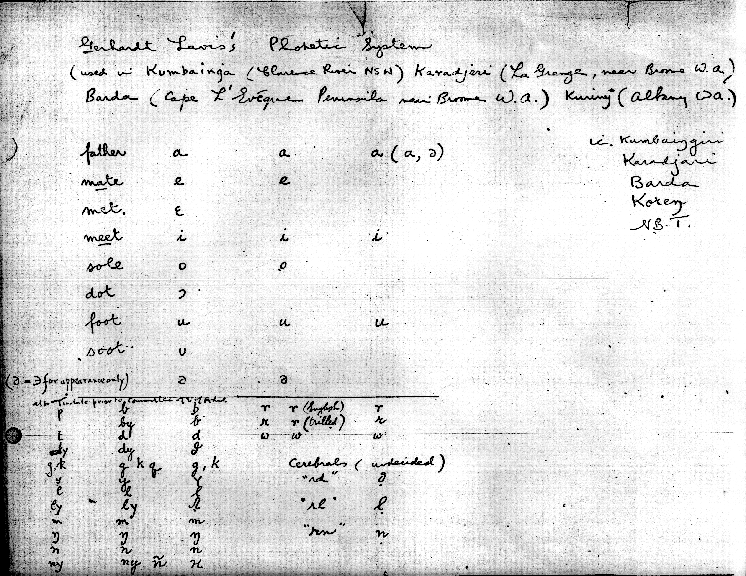
5.1MB high-resolution GIF here
| Tindale | meaning |
| α <alpha> | [ə] <schwa> |
| ...... <underdotting> | stet, let it stand |
| nn | native name |
| fb | full blood |
| t. | according to the views of (presumably for testatur) |
| Tr. |
Tribe |
Tindale's phonetic transcription conventions are set out in the
table
on page 147 of his paper 'Results of the Harvard-Adelaide Universities
Anthropological Expedition, 1938-1939' Trans Roy Soc SA 64.1,
26 July 1940.
In particular, a vertical stroke beneath a consonant means interdental,
and beneath a vowel "a" changes it from that in "cat" to that in
"cart".
(The table also allows a vertical bar to change an "e".)
Tindale was certainly aware of the fact that there were commonly two
rhotic sounds contrasting in Australian languages. In his outline
of the phonetic transcription he employed in his first publication on
the distribution of Australian Aboriginal tribes (Tindale 1940:147) he
has an ‘Alveolar Rolled’ phoneme written [r] and a ‘Cerebral Fricative’
written [r], i.e. plain r and
italic r respectively. He states in a footnote that “In the
accompanying map, letters with a vertical stroke beneath them
correspond to those shown in black letters here; those with a dot
beneath them are indicated in this text by italics.” In a fairly
extensive but not complete search, I was not able to find any letters
with a dot beneath them on the map, nor could I find any italics in the
language names in the text.
Tindale did use Gerhardt Laves’s method of distinguishing the two
rhotics in his 1938-39 collection of ‘parallel vocabularies’.
However, he did it so badly that at first I guessed which symbol
represented which rhotic wrongly. Having heard of a certain tape
recording in which he can be heard repeatedly failing to hear the
difference between an Aboriginal interviewee’s waru and warru, I thought it might be
worth making a quantitative assessment of his success in making the
distinction in his vocabularies.
To do this I chose the vocabularies of fourteen languages for which
spellings of the words, or at least a fair proportion of them, as
transcribed by a competent linguist or by me were
available. Some of the lists had very few r’s: Wik-Mungkan
had only three, Lardil and Nyawaygi (both short lists) ten and eleven
respectively. Most had between the mid twenties and the mid
thirties. Warrungu had 44 and Yukulta was well ahead of the field
with 54. In some cases there were a fair number of words that
were missing from the linguists’ vocabularies, however.
There were only two words with initial rhotics (and a third that
Tindale wrongly wrote with initial rhotic). He got one right.
Of words where the rhotic was intervocalic, Tindale got 70 of 84 right
when the rhotic was a trill, and 14 out of 57 when it was a
glide. So the appearance of comparative reliability for the
sequence VrrV is vitiated
by the many occurrences of VrV
as VrrV, not to mention
the many of VrrC as VrrVC. His apparent
intervocalic V-rhotic-V sequences were wrong more than half the time,
whichever rhotic it was.
Of 44 instances of a rhotic-initial consonant cluster, Tindale got two
right. He had the right rhotic about half the time, but usually
interpolated a vowel.
Word-final rhotics are correct in eight of 34 cases.
I conclude that there is no point in even noticing which of the two r
symbols Tindale
used.
© 2006 Gavan Breen
URL: http://www.anu.edu.au/linguistics/nash/aust/nbt/symbols.html